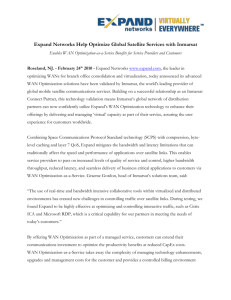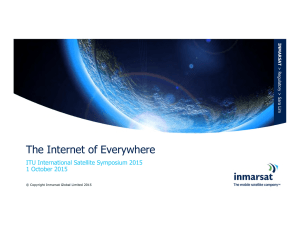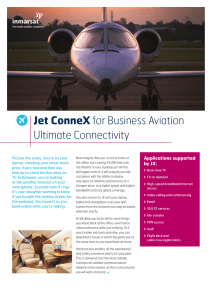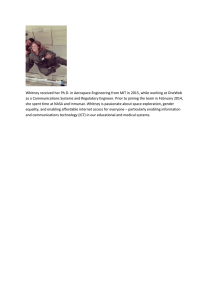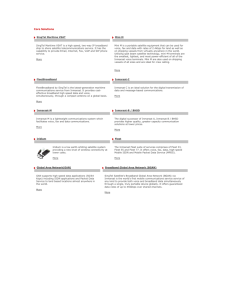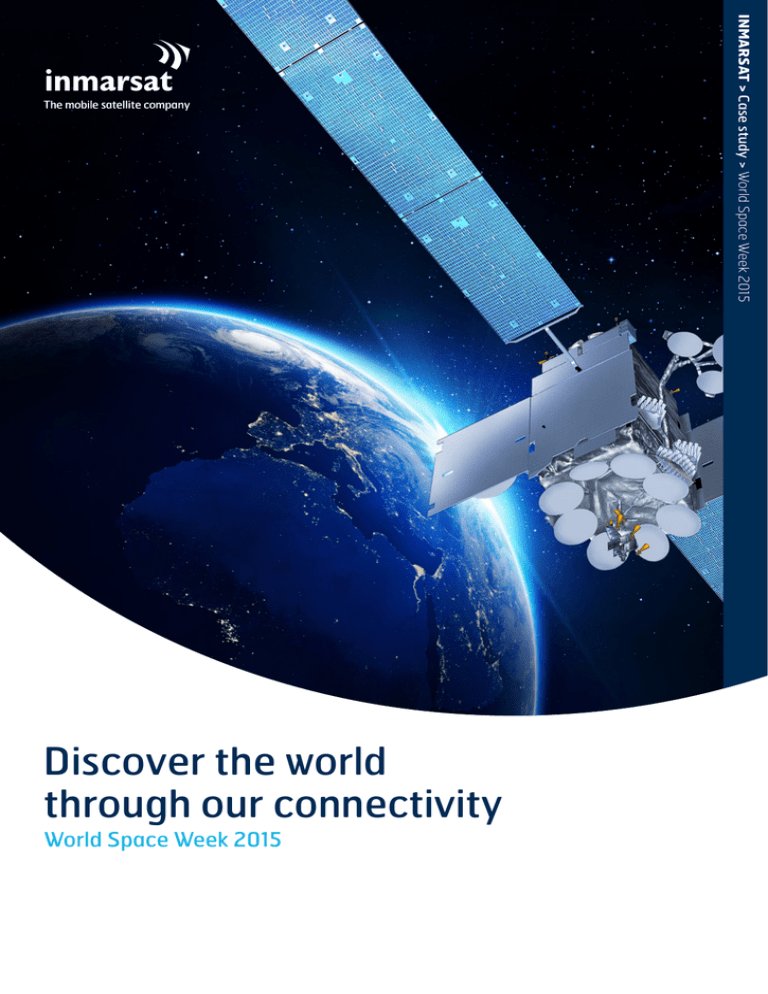
INMARSAT > Case study > World Space Week 2015
Discover the world
through our connectivity
World Space Week 2015
Keeping the world in touch
From the middle of one of London’s busiest roundabouts, there is something
very special going on. A team of skilled engineers is working around-the-clock
looking after a fleet of 12 Inmarsat communications satellites, over 35,786 km
(22,236 miles) away from Earth in geosynchronous orbit.
Word Space Week
Declared by the United Nations
in 1999 as a celebration of space
science and technology, World
Space Week takes place on 4-10
October each year with the aim
of encouraging young people to
learn about space technology and
the exciting career opportunities
that are open to them. The theme
for 2015 is Discovery.
Contact us
To find out more about Inmarsat’s involvement in
the World Space Week to inmarsat.com/wsw
linkedin.com/company/inmarsat
facebook.com/InmarsatGlobal
@InmarsatGlobal
The satellites are powering connectivity
all over the world – from the Earth’s tallest
peaks and most hostile deserts, to the
deepest oceans and furthest reaches
in space. Places where cellular networks
that we rely on in our everyday lives aren’t
available.
Whether on land, at sea or in the air,
Inmarsat makes it possible for people to
use the internet, make a phone call, update
social media, email, upload photos and even
broadcast live video, no matter how remote
their location.
To celebrate this year’s World Space Week,
we’ve taken a look at how our satellite
communications network is taking the world
on a voyage of discovery every day.
How do satellite
communications work?
A constellation (group) of three Inmarsat satellites is
needed to provide global satellite communications
coverage.
Communication satellites are
man-made and differ from natural
satellites in the Solar System,
such as the Moon
These satellites are like giant
mirrors in space, bouncing pictures,
telephone calls and internet data
from one part of the Earth to another
in superfast time
Rockets launch satellites into space
to reach their orbits
The Proton Breeze M rocket that
launched our Inmarsat-5 satellites
into space is as tall as the Leaning
Tower of Pisa
Satellites have to power themselves
and use huge solar arrays (wings) to
take energy from the sun
Our Inmarsat-5 satellites have a
solar array wingspan of 110ft – the
same length as the largest blue
whale ever recorded
Inmarsat satellites are in
geosynchronous orbit which means
they rotate at the same speed as the
Earth, to appear at the same point at
the same time every day
Our Alphasat satellite is Europe’s
largest telecommunications satellite
and is as tall as a double decker bus,
weighing more than 6.6 tonnes at
launch
Each satellite is designed to last
around 15 years but can last several
years longer
Our communications satellites
receive information from the sender
on Earth – called an uplink – and
beam it back down to a Satellite
Access Station on Earth – a downlink
– which then sends the data or call
to the receiver
To use our satellite communications
you need an antenna or terminal to
connect to the satellite
A journey of discovery
World Space Week 2015 is important because it reminds us all of the great
strides that space and technology have made over the years to understand
the universe we live in.
For Inmarsat, our satellites are not only powering connectivity across the globe, they are also enabling us to discover a
whole new world through science, exploration, sport, education and climate research, to name just a few examples.
Through our connectivity we take millions of people on a journey of discovery every day through social media, TV, news,
websites and blogs. We also play a vital role in enhancing scientific knowledge and understanding. What will science and
space help you discover today?
Life at the extreme
Nine months, seven teams, 38,739 nm – the Volvo Ocean Race is sailing’s toughest
challenge. Throughout the adventure fans were able to discover what it was like to
live life at the extreme thanks to our connectivity, as Onboard Reporters on each
boat sent back amazing videos, stunning images and compelling stories from the
world’s oceans. Our vital safety, tracking and crew communications services also
enabled the crew to discover the best routes to take to win the race.
Pushing endurance levels
Veteran adventurer Sir Ranulph Fiennes took part in the gruelling Marathon des
Sables, running 251 km (156 miles) across the Sahara Desert to support UK cancer
charity Marie Curie. Pushing his endurance limits to the point where he could barely
walk, he discovered his determination to complete the challenge and raise over
£135,000 for the charity. We were able to join him on his journey via live broadcasts
with the BBC from the middle of the desert, powered by our satellite connectivity.
Battling against the odds
We tracked ex-British Army Royal Marine Peter Bowker as he become the world’s
first amputee to cross the Greenland ice cap unsupported – discovering for himself
that even with one leg he could overcome any challenge, inspire others by his
actions and raise money for a charity close to his heart – Help for Heroes. Via
Inmarsat the team shared breath-taking views from one of the most remote places
on Earth, when they skied nearly 500 km (373 miles) across the icy wilderness.
Deep space discovery
We’re proud to have been part of the European Space Agency’s (ESA) Rosetta
mission, which saw the first landing of a probe on a comet. Inmarsat is powering
communications from the Rosetta spacecraft and robot probe Philae, as they
transmit images and critical scientific data discovery from the Comet 67P/
Churyumov-Gerasimenko, 500 million km away.
Tsunami warning system
Our machine-to-machine (M2M) IsatData Pro service is helping to discover early
warning signs of natural disasters and save lives by monitoring tectonic plate
activity for the Earth Observatory of Singapore (EOS). The EOS carries out research
on earthquakes, volcanic eruptions, tsunamis and climate change in Southeast Asia
to help prevent devastating effects, such as the 2004 tsunami in Indonesia which
killed 170,000, from ever happening again.
inmarsat.com/wsw
While the information in this document has been prepared in good faith, no representation, warranty, assurance or undertaking (express or implied) is or will be made, and no
responsibility or liability (howsoever arising) is or will be accepted by the Inmarsat group or any of its officers, employees or agents in relation to the adequacy, accuracy, completeness,
reasonableness or fitness for purpose of the information in this document. All and any such responsibility and liability is expressly disclaimed and excluded to the maximum extent
permitted by applicable law. INMARSAT is a trademark owned by the International Mobile Satellite Organisation, the Inmarsat LOGO is a trademark owned by Inmarsat (IP) Company
Limited. Both trademarks are licensed to Inmarsat Global Limited. All other Inmarsat trade marks in this document are owned by Inmarsat Global Limited. © Inmarsat Global Limited
2015. All rights reserved. World Space Week September 2015.


